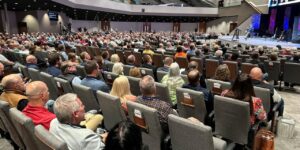
WAKE FOREST, N.C. (BP)–The last 12 verses of the Gospel of Mark are an ongoing source of debate and fascination among serious students of Scripture, including a recent New Testament symposium at Southeastern Baptist Theological Seminary.
The symposium, titled “The Last 12 Verses of Mark: Original or Not?” featured five scholars in a good-natured debate on this difficult passage.
Participants included Dallas Theological Seminary’s Darrell Bock, a New Testament professor, and Daniel Wallace, a New Testament and Greek professor; Keith Elliott, a professor of New Testament at the University of Leeds in England; and two professors of Greek and New Testament at Southeastern, Maurice Robinson and David Alan Black.
The panel brought a diversity of views to the subject: Robinson and Black argued for the authenticity of the ending of Mark, while Elliott and Wallace argued that it is not original to the Gospel. Bock responded to both views with a final presentation on the state of current research.
David Beck, associate dean of biblical studies at Southeastern and the session moderator, noted at the beginning of the symposium that the question of the authenticity of the ending of Mark is not even debated in some quarters. Liberal scholars take it for granted that the ending was contrived later.
Wallace and Elliott argued that there is both evidence in the text of the Gospel itself as well as evidence among existing New Testament manuscripts that point to the exclusion of the last 12 verses.
“Which is more likely: That scribes would intentionally add these verses or that they would intentionally omit them?” Wallace asked rhetorically in his presentation.
Wallace conceded that if the last 12 verses were excluded from the original text of Mark’s Gospel, it does raise serious questions. Chief among them: why a writer would conclude his Gospel with no resurrection appearances of Jesus, particularly since Jesus predicts His resurrection three times in Mark’s Gospel.
Wallace countered that claim by arguing that Mark intentionally “left his readers hanging, wanting more,” that the Gospel was intended to spur those interested in Christ’s claims to be Messiah to investigate further.
“To be sure, such suspended endings were rare, but they appeared and they were effective,” Wallace said. “The intent was to shock his readers with an abrupt ending.”
Further, Wallace noted that if Mark intentionally left resurrection appearances out of his Gospel account, it explains why scribes later would want to add them and possibly how the longer ending of Mark came into existence.
Wallace argued that manuscript evidence also points to the exclusion of the longer ending, noting that what scholars consider the oldest existing manuscripts –- named Codex Vaticanus and Codex Sinaiticus -– do not contain the longer ending.
Robinson, however, countered in his presentation that more than 95 percent of existing manuscripts do contain the long ending, a fact that must be accounted for in the debate over the Gospel.
In fact, if it were not for the privileged position many scholars assign to Codex Vaticanus and Codex Sinaiticus, there would not even be a discussion, Robinson said, and the longer ending of Mark would be assumed original.
Robinson also pointed out that although some church fathers (particularly from the fourth century) questioned the authenticity of the longer ending, their opinion should not negate the fact that many earlier church fathers — including Iranaeus and Justin Martyr — believed the last 12 verses to be a part of Mark’s Gospel.
Robinson said theorizing that Mark intended to entice readers with an abrupt stylistic ending “requires a sophisticated and postmodern viewpoint not present in antiquity.”
Black joined Robinson in his view of the authenticity of Mark 16:9-20, pointing out that the long ending generally had been assumed to be original until the 19th century.
“I am absolutely convinced that the long ending is originally based on external evidence alone, and that it deserves the canonical status it has enjoyed throughout church history,” Black said. “I therefore have consistently preached and taught these verses as the inspired Word of God. In fact, I have even been known to go so far as to quote the Markan version of the Great Commission in public.”
In Black’s view, the Gospel of Mark is essentially the recollections of Peter, written down while he preached in Rome toward the end of his life. Contrary to many scholars, Black argued that Mark was actually the third Gospel written after Matthew and Luke.
Black argued that the recollections of Peter end at 16:8 and that Mark added the ending which is now in dispute.
“As an act of piety to the memory of Peter, Mark then decided to publish an edition of the text that would include the necessary sequel to the passion and death of the Master,” Black said.
Black added in reflecting on the conference, “Even if we cannot agree on the originality of that verse, we can all agree that the purpose of New Testament scholarship, and of scholarship in general, is to glorify God and advance His Kingdom on earth by sharing His love with those who have never heard.”
Ray Clendenen, publisher of B&H Academic with LifeWay Christian Resources, was in attendance at the April 13-14 symposium and noted that B&H plans to release the collected addresses from the conference in an edited volume.
–30–














